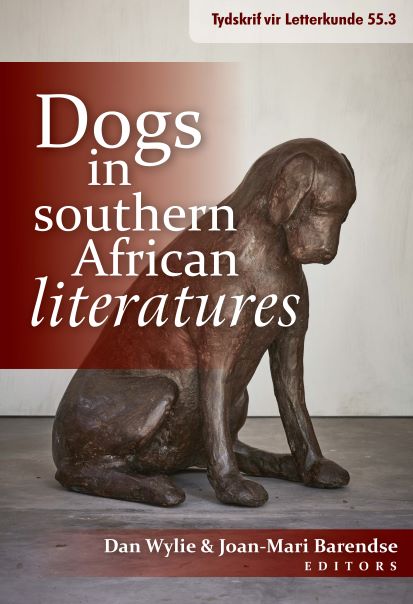Symbolic values of the dog in Afrikaans literature
DOI:
https://doi.org/10.17159/2309-9070/tvl.v.55i3.5506Keywords:
Afrikaans literature, ambivalent portrayal of dogs, animal studies, symbolic value of the dogAbstract
The dog is a universal, archetypical symbol of fidelity and loyalty. However, in literature—and especially in South African literature—the dog (as well as the hyena and the wolf) often symbolises the diabolical. In some instances the dog is also symbolic of the dark side of human nature, of dehumanisation and even of death. The canine symbol in Afrikaans literature has both European and African origins. When canines appear in their natural (literal) form in Afrikaans poems and narratives, they are for the most part portrayed in a positive (compassionate) way. As soon as they appear in a figurative (allegorical) capacity though, as a symbol or metaphor, they mostly represent something ominous. The ambivalent nature of dogs—they are both caring and brutal—is reflected in Afrikaans literature. In this article the contradictory (symbolic) depiction of canines will be explored in various Afrikaans poems and novels. This article thus falls within the framework of animal studies, the interdisciplinary field which analyses how nonhuman animals are portrayed and viewed within literature.
Downloads
References
Anker, Willem. Buys:’n Grensroman. Kwela, 2014.
Bersson, R. Responding to Art: Form, Content and Context. McGraw-Hill Humanities, 2004.
Blum, Peter. Steenbok tot Poolsee: Verse. Tafelberg Publishers, 1955.
Burger, W. “Kies ’n Boek—Buys: ’n Grensroman”. Vrouekeur, 27 February, 2015.
Canonici, N.N. Tricksters and Trickery in Zulu Folktales. Unpublished PhD dissertation, University of Natal,
Celliers, Jan F.E. Die saaier en ander nuwe gedigte. De Bussy, 1918.
Crous, M. “‘Sonder siel en anoniem’: Elisabeth Eybers se ‘Huiskat’ in die konteks van dierestudies”. Tydskrif
vir Geesteswetenskappe, vol. 55, no. 3, 2015.
Estés, C.P. Women Who Run with the Wolves: Myths and Stories of the Wild Women Archetype. Ballantine
Books, 1992.
Fourie, Corlia. Liefde & geweld. Tafelberg Publishers, 1991.
Goethe, J.W. von. Faust. Afrikaans translation by Eitemal. Nasionale Boekhandel, 1966.
Goosen, Jeanne. ’n Pawpaw vir my darling. Kwela, 2006.
Goosen, Jeanne. Louoond. HAUM-Literêr, 1987.
Human, T. “Grootse roman skep ’n eie taal”. Die Volksblad, 10 November, 2014.
Kannemeyer, J.C. Die Afrikaanse literatuur 1652–1987. Academia, 1988.
Louw, Anna, M. Wolftyd. Tafelberg Publishers, 1991.
Louw, Anna. Vos. Tafelberg Publishers, 1999.
Louw, N.P. van W. Gestaltes en diere. Tafelberg Publishers, 1942.
Miles, John. Op ’n dag, ’n hond. Human & Rousseau, 2016.
Mthatiwa, S.D.M. Human-Animal Relationships and Ecocriticism: A Study of the Representation of Animals in
Poetry from Malawi, Zimbabwe, and South Africa. Unpublished PhD dissertation. Witwatersrand
University, 2011.
Müller, Petra. Die aandag van jou oë: gedigte vir die liefde. Tafelberg Publishers, 2002.
Schneider-Adams, L. Art Across Time. McGraw-Hill Humanities, 2002.
Snyman, H. “LitNet Akademies-resensie-essay: Buys deur Willem Anker”. Litnet. 7 November 2014.
.
Steyn, P & van Heerden, C. “Op Buysdorp is almal familie”. Beeld, 2 April, 2016.
Strachan, Alexander. Die jakkalsjagter. Tafelberg Publishers, 1999.
Swart, S. “‘But where’s the bloody horse?’ Textuality and corporeality in the ‘Animal Turn’.” Tydskrif vir
literatuurwetenskap vol. 23, no. 3, pp. 271–292, 2007.
Taljaard-Gilson, G. “’n Ondersoek na die waarde van historiese fiksie: drie geskiedkundige romans in oënskou
geneem”. LitNet Akademies. 12 February 2013.
fiksie-drie-geskiedkundige-romans-in-oenskou/#Artikel>.
Van der Merwe, C. “Wolftyd—Anna M. Louw”. LitNet-Leeskringe. 1999.
.
Van Niekerk, Marlene. Triomf. Queillerie, 1994.
Van Schalkwyk, P. “Our hunting fathers”. Litnet, 9 December 2014.
buys-en-our-hunting-fathers>.
Van Sittert, L & Swart, S. “Canis Familiaris: A Dog History of South Africa”. South African Historical Journal,
, 138–173, 2003.
Van Staden, Ilse. Goeie dood wat saggies byt. Protea Boekhuis, 2016.
Verster, F. P. “’n Kultuurhistoriese ontleding van pikturale humor, met besondere verwysing na die werk van T.
O. Honiball”. Unpublished PhD dissertation, University of Stellenbosch, 2003.
Viljoen, L. “Petra Müller”. Perspektief en Profiel: Afrikaanse literatuurgeskiedenis. Deel III. Ed. H. P. van
Coller. J. L. van Schaik, 2016: pp. 561–578.
Visagie, A. “Moderniteit en die Afrikaanse literatuur”. Inaugural speech delivered on 16 May 2016:
Stellenbosch University, 2016.
Downloads
Published
Issue
Section
License
Copyright (c) 2018 Tydskrif vir Letterkunde

This work is licensed under a Creative Commons Attribution-ShareAlike 4.0 International License.


 https://orcid.org/0000-0001-6465-6584
https://orcid.org/0000-0001-6465-6584


.png)